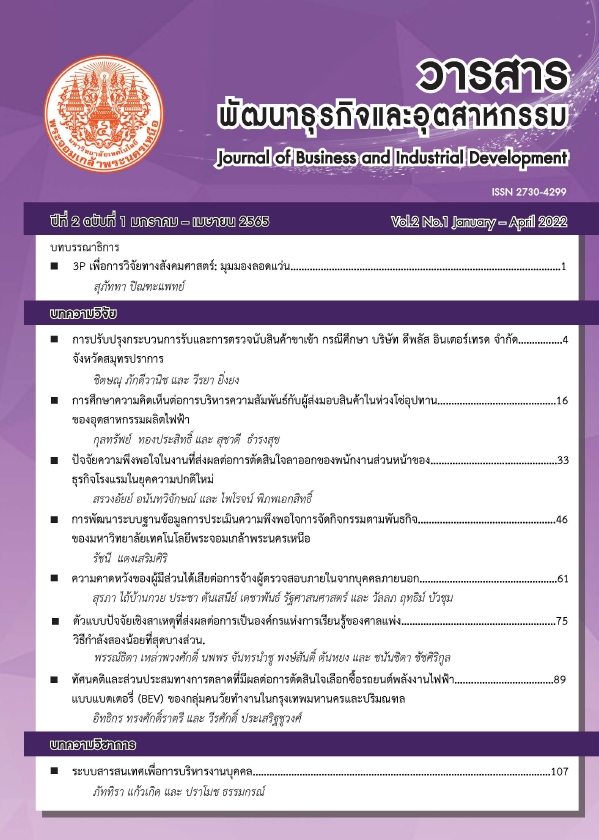Causal Model of Factors Affecting Learning Organization of The Civil Courts:Partial Least Squares Approach
Keywords:
Learning Organization, Civil Court, Partial Least SquaresAbstract
This research aimed to study the causal model of factors affecting the establishment of a learning organization of the civil courts in Bangkok. The sample included 255 personnel of the civil courts in Bangkok by means of stratified random sampling. A questionnaire was used as a research instrument. Data were analyzed by descriptive analysis and partial least squares structural equation modeling analysis. The research results revealed the propriety and discriminant validity of the model with the model in overall suggesting SRMR < .08; α, CR, ρA > .70; AVE > .05; and HTMT < . Change leadership was found to have a direct effect on organizational management, and indirect effect on knowledge management, and on being a learning organization. The organizational management had a direct effect on knowledge management, and had direct and indirect effects on being a learning organization. Knowledge management had a direct effect on being a learning organization, at the .05 level of significance. This research therefore suggested that leaders of the organizations should modify the organizational management strategies to support knowledge management that will be used in the development of learning organizations.
References
Rowden, R.W. (2001). The Learning Organization and Strategic Change. SAM Advanced Management Journal, 66(3), 11-16.
Senge, P.M. (2006). The Fifth Discipline: The Art and Practice of The Learning Organization. (2nd ed). London: Century Press.
Ubben, G.C., Hughes, L.W. & Norris, C.J. (2015). The Principal: Creative Leadership for Excellence In Schools. (8th ed). London: Pearson.
Bhatti, W.A., Hussain, N., & Iqbal, J. (2013). Leadership Role in Integrating Knowledge Management Enablers. World Applied Sciences Journal, 26, 55-60.
นิมิตร โสชารี. (2559). รูปแบบการพัฒนาองค์กรแห่งการเรียนรู้ของเทศบาลตำบลในเขตภาคตะวันออกเฉียงเหนือ. วารสารสังคมศาสตร์ปริทรรศน์, 5(2), 27-52.
Celep, C. & Cetin, B. (2005). Teacher’ S Perception About the Behaviors of School Leaders with Regard to Knowledge Management. International Journal of Educational Management, 19(2), 102-117.
Garvin, D.A. (1993). Building a learning organization. Harvard Business Review, 71(4), 78-91.
Debowski, S. (2006). Knowledge management. Sydney: John Wiley & Sons.
Marquardt, M.J. (2002). Building the Learning Organization: Mastering The 5 Elements for Corporatelearning. (2nd ed). CA: Davies-Black Publishing.
กัญยาภักษณ์ พะระนะพันธ์ และสมบูรณ์ ศิริสรรหิรัญ. (2556). การเป็นองค์กรแห่งความสุขกับการจัดการความรูและการมีส่วนร่วมที่มีอิทธิพลต่อการเป็นองค์การแห่งการเรียนรู้ของบัณฑิต. วารสารบริหารการศึกษา มหาวิทยาลัยศิลปากร, 3(2), 117-127.
Swart, J., Mann, C., Brown, S., & Price, A. (2008). Human Resource Development: Strategy and Tactics. Butterworth Heinema: Oxford.
Bass, B.M. & Avolio, B.J. (1994). Improving Organizational Effectiveness Through Transformational Leadership. Thousand Oaks, CA: SAGE.
Boris, K. & Jens, G. (2019). HR Governance: A theoretical Introduction. Springer: Cham, Switzerland.
Certo, S.C. Modern management. (8th ed). Upper Saddle River, NJ: Prentice-Hell.
Schreiber, J., & Nora, A., & Stage, F. (2006). Reporting Structural Equation Modeling and Confirmatory Factor Analysis Results: A Review. The Journal of Education Research, 99(6), 323-338.
Rademaker, M.E. & Schuberth, F. (2020). cSEM: Composite-Based Structural Equation Modeling. Package version: 0.4.0.9000. https://m-e-rademaker.github.io/cSEM/.
Henseler, J., Ringle, C.M. & Sinkovics, R.R. (2009). The Use of Partial Least Squares Path Modeling in International Marketing. In Sinkovics R.R., Ghauri, P.N, (Eds.) Advances in international marketing. (pp. 277-320). Bingley: Emerald.
Fornell, C. & Larcker, D.F. (1981). Evaluating Structural Equation Models with Unobservable Variables and Measurement Error. Journal of Marketing Research, 18(1), 39-50.
Henseler, J., Ringle, C.M. & Sarstedt, M. (2015). A New Criterion for Assessing Discriminant Validity in Variance-Based Structural Equation Modeling. Journal of the Academy of Marketing Science, 43(1), 115-135.
Hair, J.F., Black, W.C., Babin, B.J. & Anderson, R.E. Multivariate Data Analysis. (8th ed). Cengage: UK.
กัลยารัตน์ ธีระธนชัยกุล และภัทราทิพย์ ทรงบุญญา. (2558). การศึกษาปัจจัยเชิงสาเหตุที่มีอิทธิพลต่อผลการปฏิบัติงานของอาจารย์สถาบันอุดมศึกษาเอกชนในประเทศไทย. วารสารธุรกิจปริทัศน์, 7(2), 115-136.
รุ้งนภา จันทร์ลี. (2562). ภาวะผู้นำการเปลี่ยนแปลงของผู้บริหารสถานศึกษาที่ส่งผลต่อการเป็นองค์กรแห่งการเรียนรู้ของสถานศึกษา สังกัดสำนักงานเขตพื้นที่การศึกษาประถมศึกษา เขต 2 [วิทยานิพนธ์ปริญญามหาบัณฑิต ไม่ได้ตีพิมพ์]. มหาวิทยาลัยราชภัฏรำไพพรรณี.
ไชยสิทธิ์ ปิยมาตย์. (2556). ปัจจัยที่ส่งผลต่อการเป็นองค์กรแห่งการเรียนรู้ของโรงเรียนเหล่าสายวิทยาการของกองทัพบก. [วิทยานิพนธ์ปริญญาดุษฎีบัณฑิต ไม่ได้ตีพิมพ์]. มหาวิทยาลัยศรีปทุม.
Downloads
Published
How to Cite
Issue
Section
License

This work is licensed under a Creative Commons Attribution-NonCommercial-NoDerivatives 4.0 International License.




